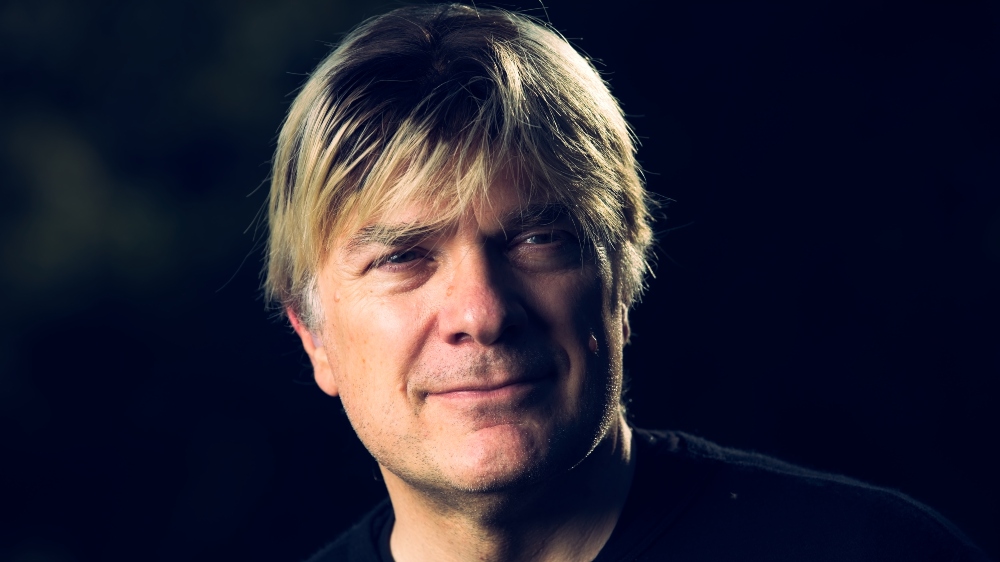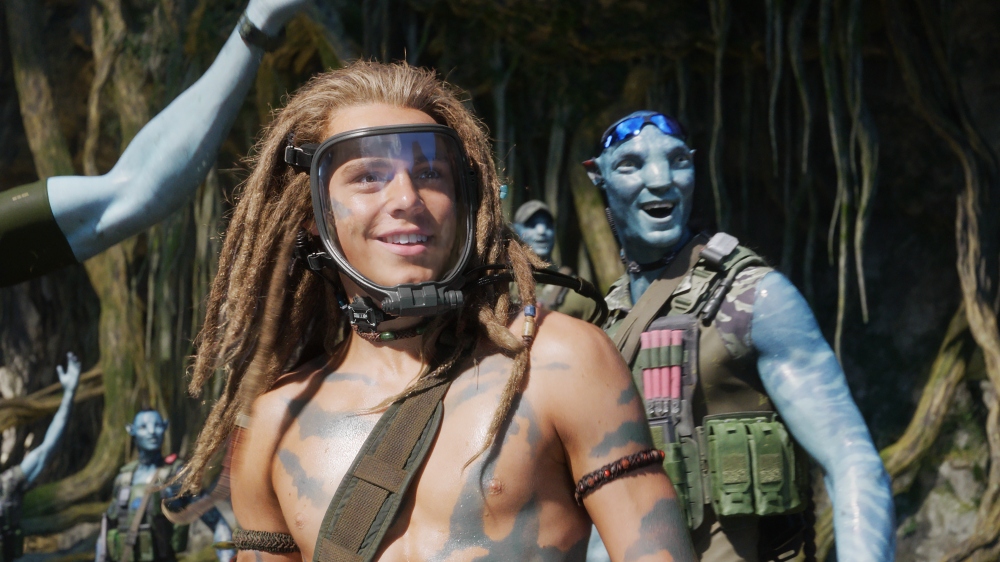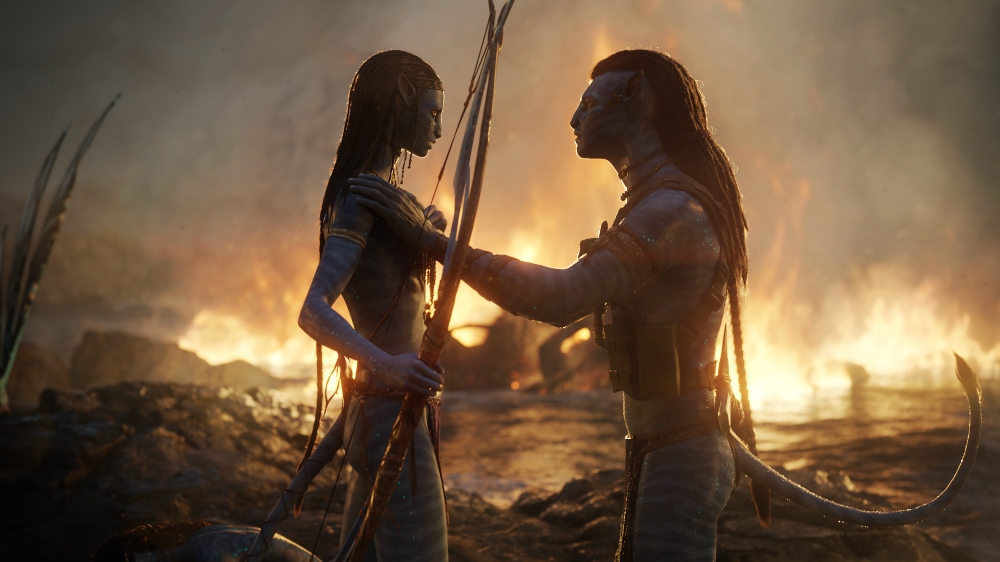Simon Franglen took over scoring duties for Avatar: The Way of Water from James Horner following the legendary composer’s tragic passing, and he pays tribute to Horner’s iconic theme from the first film early on in the sequel, which has already grossed more than $1.5 billion worldwide.
The Way of Water finds Jake Sully (Sam Worthington) and his wife Neytiri (Zoe Saldaña) facing off against a familiar nemesis — Stephen Lang‘s Col. Quaritch — while raising a family and gaining a new ally in another area of Pandora. Delayed for several years, the film is the first of four planned sequels to the original 2009 blockbuster, which won three Oscars.
Franglen was kept busy for much of The Way of Water as Director James Cameron only gave him a few minutes off over the course of the three-hour-plus trip to Pandora. While utilizing Horner’s original Avatar themes early on in the forest, Franglen also composed new themes for the Sully family and various new characters.
Below the Line recently spoke to Franglen, and the composer revealed his favorite tracks and why one of them meant so much to him after scoring the film, which continues to dominate the box office. Franglen’s original score is also one of 15 to be shortlisted by the Academy for Oscar considerations.

Below the Line: You inherited the scoring duties on this film from James Horner, so what were you looking to do in terms of honoring his work in the first film while still making the score for Avatar: The Way of Water your own?
Simon Franglen: Well, that came very much from what Jim wanted. Jim and I talked about the fact that we wanted to carry some of the themes and some of the ideas from the first one. [There was] one theme, in particular, that we wanted to take and carry with us, and we thought it would be good to be able to honor James in that way. I use those at the beginning of the film. But then as the film evolves, we needed new themes. We have new characters, we have new places on Pandora, and all of this required a new language. Jim had evolved his thinking on how the score should sound compared to [the first] Avatar, which was obviously 13 years ago.
I was guided by Jim. I knew he wanted a slightly more thematic score, though [the first] Avatar has got huge themes and there are a lot of different themes in there. He wanted more specific things to do with… there is a family theme. There is a theme for the Metkayina and their connection with the sea. There is a theme for Payakan, and even a theme for Quaritch, and Kiri, and so on. [Those] were some of the things that he asked of me, [and one] was to create… a library of more thematic material that we [could] use for our characters.
BTL: What was your process when it came to composing the score — did you start from the script stage or after seeing some footage?
Franglen: Oh, no. I started right at the beginning [with] the script, because in the first paragraph of Avatar 2, as it was called then, it says, ‘Zoe sings the Songcord.’ I had to write the Songcord — that was the very first thing I had to do — which was this song that Zoe sang so beautifully in the film. I had to create that and once I got that, Jim said it needed to feel ancient, yet have the feeling of a mother’s love for her children. The Songcord is this idea that the Na’vi can sing their heritage. They have a Songcord for, say, their grandmother, and they can sing through their grandmother’s life.
Every time a new child is born, they make a new Songcord and they start to sing their lives and so on. It was a very important concept for the film that Jim wanted. Once I had that theme, that then actually became what I’m calling the Family or Home Tree. It’s this rather big, sweeping theme and that’s really the thing I’m using for family. That was the first theme. I wrote that theme [at the] beginning of 2018, so we’ve been on this journey [for] a while.

BTL: How long did you spend working on the score for The Way of Water?
Franglen: Well, actually, the proper score I started at the beginning of [2022], so it’s been a whole year’s work. There is a lot of music in this film. As we said, it’s overwhelmingly a new score, but there are three hours of music in the film. The film is three hours and 12 minutes and when you take four or five minutes away for a song, then there are about five or six minutes of silence. Jim gave me five or six minutes off in three hours, so there was a lot to write. And obviously, not every cue is right the first time. There is a lot more than three hours. I can show you this — [Grabs the printed sheet music for the score] — I received these just yesterday. This is the score.
BTL: Wow.
Franglen: To give you a concept of this scale, this is all sheet music, and there are hundreds and hundreds and hundreds of pages of sheet music. Normally, we get one of these and it’s about maybe two-thirds of this [one], if I have one made up. For this film, it’s that. I think it gives you an idea of how much music I had to write.
BTL: It’s my understanding you’ll be composing the rest of the franchise as well, yes?
Franglen: Yeah, they have nailed me down, so I am signed for all the sequels until he decides that he doesn’t love me anymore, but at the moment, I stay on through [Avatar] 5, so all [of] those.
BTL: I think you already touched on this, but how did you decide where to incorporate James Horner’s original themes and where to add the new music you wrote?
Franglen: Oh, I think we just talked about it earlier, but I used the original themes early on, more to do with the forest and sometimes to do with — for instance, if Jake and Neytiri [are] flying, then that seemed an appropriate time to use the flying music from [the first] Avatar, because that was about Jake and Neytiri connecting and that seemed to make sense there. I sometimes would use a motif later on in the score. You can hear it sometimes. You’ll hear moments of A1 — I’ll quote a few bars here or a few bars there. I wanted to integrate it into the score so that it felt organically whole. It didn’t just feel like it’d been snipped in. That was mainly the thing. It was something that Jim and I really wanted to be a situation where we use those motifs from A1 constructively because there’s a lot of score to do. There’s a lot of stuff to do. I’ve got, in theory, another three films to write as well.
BTL: I assume you’ll be revisiting some of the new themes in this film in the next one, too, right?
Franglen: Yes, because now we have a family theme. Now we have a theme for Lo’al and Payakan. Now we have a theme for Kiri, who is such an important character [in] this film. We even have a theme for the RDA and Quaritch because there is an RDA theme and there’s a Quaritch theme that fits. They actually connect. They’re sort of intertwined. There are some Easter eggs in my score that will not — you won’t know why they’re there now and they may be in [Avatar] 3, 4, or 5. There are things in the score here that will start to make more sense as we go through the series.
BTL: Did you have a favorite track from The Way of Water score or is it too hard to choose just one?
Franglen: I’ll give you two that I’m very proud of. One is “The Tulkun Return,” which I was very proud of. That was one I wrote initially off the script. I read this and I started writing that off the script. And then obviously, when we saw the images, it just seemed to fit so perfectly. The other one is “From Darkness to Light,” where Jim said to me, ‘we have to make the whole audience cry [with] this.’ I wrote a cue and it was almost five minutes long. I’ve written it and I’m like, ‘this is great, this is brilliant.’ [He says,] ‘Yeah, it’s good.’ A couple of weeks later, ‘nah, not feeling it.’
So [I] go back, write it again, and he said, ‘Yeah, better but you still haven’t quite got it there.’ I’ve now written 10 minutes of music that have been thrown away. I wrote the third one. I sat down and wrote it. Within five seconds, he starts crying because he’s a very emotional man, and he cries all the way to the end. At the end, he said, ‘okay, yeah, you may have gotten me this time.’ For that, I made Jim Cameron cry, and therefore that would be the cue that means something [to me].
BTL: Were there other tracks that evolved as much as that one did?
Franglen: There are a couple of other cues I wrote maybe 9-10 times. That one is particularly special because it has an emotional flow that I feel. But no, there are other cues… there was a cue where I just kept looking at it and was never totally happy. This is down to me, because the great thing [about] working with Jim is, I only have two people to please — myself and Jim. It would never go to Jim until I was happy myself. There was one cue in particular where I just kept rebuilding, never quite there, and then eventually [I] just settled and I was extremely happy with the way that it worked. There are a number of cues like that where I’ve got [some] differences.
The other thing I would say is that you will notice that… Jim wanted me to write a more muscular approach to the action music than in [the first] Avatar, and that was a conscious decision from him. He heard some work I did on the train attack, which is one of the early cues, and said, ‘I like that, I want you to use this more later on,’ and so on. I was originally doing more symphonic action music with lots of things and then he said, ‘Well, yes, that’s great. I like this, but could you add some more muscle in there as well?’ I think that’d be the best way of putting it. There’s a lot of drive in the action music.

BTL: What were some of the challenges that came with working on the score during a pandemic?
Franglen: This was the tough bit. I went down to New Zealand, thinking that they built me studios next to Jim Cameron’s edit suite. The idea was that he and I would collaborate on a daily basis. He’d wander over [to] listen to stuff and so on. About three weeks in, New Zealand goes into lockdown, into orange alert. New Zealand was meant to be this place — when I first arrived, I did my quarantine. Nobody was masking, everything was fine, and then suddenly, they go into quarantine. I went into an isolation bubble with three other people, and Jim Cameron was [on] the other side of the door.
For almost six months, all I saw [were] three other people. Everybody else was via Zoom. I was living Severance. I would get up in the morning, I would go and cycle to my studio, I’d work and see three other people, and I’d cycle home and go to sleep. Every day was like that. Sometimes, I would have a Zoom call with Jim, where I could hear him through the door. Half a second later, the Zoom link would come through and voice would come through Zoom. He was [on] the other side of the door but we couldn’t see each other because we were concerned that if the entire production got Covid, the whole lot would be shut down for six weeks. We didn’t have the time. We finished printing the whole film on Dec. 1, which is incredibly late. If we’d lost even two weeks, the film would not be coming out now.
BTL: Do you have a preferred recording studio for scores because of how it sounds?
Franglen: We did it at Fox. We did it at the Newman stage because it’s one of the great stages and it’s the home of Avatar. We did [the first] Avatar there. I’m lucky I have Simon Rhodes, who’s one of the great engineers in the world, and also Brad Haehnel. Simon is from London and works at Abbey Road. Brad is in Los Angeles. They both have done a phenomenal job. Simon had to come down with me to New Zealand to mix because we were mixing and dubbing in New Zealand, and then Brad stayed in Los Angeles and was recording. Those guys there are phenomenal. I have a room at AIR Studios in London so that is also a home for me as well. I will always say to my family at AIR, that is my home as well.
Avatar: The Way of Water is now playing in theaters across the globe courtesy of 20th Century Studios. Click here to read our interview with Production Designers Ben Procter and Dylan Cole, click here to read our interview with Editor Stephen Rivkin, and click here to read our interview with Costume Designer Deborah Scott.





